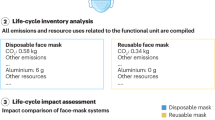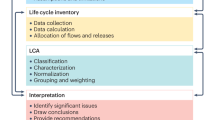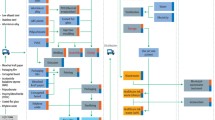Abstract
Life cycle assessment (LCA) is a method to understand and reduce the environmental impact of products over their life cycle. Although general guidelines to perform LCAs are available, specific recommendations on performing and reporting the life cycle impact assessment (LCIA) step in a standardized way are lacking. This lack can lead to incomplete results, followed by misinterpretation. In the LCIA step, the magnitude and significance of the potential environmental impacts are quantified and evaluated. Here, we describe how to systematically perform and report the LCIA step, identify the most meaningful LCA results and check their robustness. To develop the procedure, we used the widely applied LCIA methodology ReCiPe, which includes so-called characterization factors that express the environmental impact per unit of emission or extraction for 18 midpoint categories, such as global warming and acidification, and three endpoint categories (human health damage, ecosystem damage and resource scarcity). The characterization factors are developed for three perspectives, addressing inherent value choices in the calculation models. To demonstrate its use, our method was applied to a passenger car tire case study. We argue for the inclusion of all three endpoint categories and all three perspectives in the initial assessment. Furthermore, we recommend including a midpoint-to-endpoint contribution analysis on the impact results to identify the most important midpoint categories. Being comprehensive on the LCIA results will lead to a clear, distilled message to stakeholders to decrease environmental impacts, without unintended burden shifting across the supply chain or between different environmental impacts.
This is a preview of subscription content, access via your institution
Access options
Access Nature and 54 other Nature Portfolio journals
Get Nature+, our best-value online-access subscription
$32.99 / 30 days
cancel any time
Subscribe to this journal
Receive 12 print issues and online access
$259.00 per year
only $21.58 per issue
Buy this article
- Purchase on SpringerLink
- Instant access to full article PDF
Prices may be subject to local taxes which are calculated during checkout









Similar content being viewed by others
References
Consoli, F. et al. Guidelines for Life-Cycle Assessment: A “Code of Practice” (Society of Environmental Toxicology and Chemistry, 1993).
ISO. ISO 14040: Environmental Management — Life Cycle Assessment — Principles and Framework. Technical Standard (International Organization for Standardization, 2006).
ISO. ISO 14044: Environmental Management — Life Cycle Assessments — Requirements and Guidelines (International Organization for Standardization, 2006).
Kirchain, R. E., Gregory, J. R. & Olivetti, E. A. Environmental life-cycle assessment. Nat. Mater. 16, 693–697 (2017).
Curran, M. A., (ed.) Goal and Scope Definition in Life Cycle Assessment (Springer, 2017).
Ciroth, A. & Arvidsson, R. Life Cycle Inventory Analysis (Springer, 2021).
Wernet, G. et al. The ecoinvent database version 3 (part I): overview and methodology. Int. J. Life Cycle Assess. 21, 1218–1230 (2016).
Peters, J. F. Best practices for life cycle assessment of batteries. Nat. Sustain. 6, 614–616 (2023).
Hauschild, M., Rosenbaum, R. & Olsen, S. I. Life Cycle Assessment: Theory and Practice (Springer, 2017).
Finkbeiner, M. Carbon footprinting—opportunities and threats. Int. J. Life Cycle Assess. 14, 91–94 (2009).
Zuiderveen, E. et al. The potential of emerging bio-based products to reduce environmental impacts. Nat. Commun. 14, 8521 (2023).
Mulya, K. S., Zhou, J. Q., Phuang, Z. X., Laner, D. & Woon, K. S. A systematic review of life cycle assessment of solid waste management: methodological trends and prospects. Sci. Total Environ. 831, 154903 (2022).
Aguiar, G. J. A. et al. Use of life cycle assessment as a tool to evaluate the environmental impacts of textile effluents: a systematic review. Environ. Sci. Pollut. Res. Int. 30, 76455–76470 (2023).
Hauschild, M. & Huijbregts, M. A. J. Life Cycle Impact Assessment (Springer, 2015).
Guinée, J. in Life Cycle Impact Assessment. LCA Compendium – The Complete World of Life Cycle Assessment (eds. Hauschild, M. Z. & Huijbregts, M. A. J.) 17–37 (Springer, 2017).
Goedkoop, M. et al. ReCiPe 2008: a life cycle impact assessment method which comprises harmonised category indicators at the midpoint and the endpoint level. RIVM https://www.rivm.nl/documenten/a-lcia-method-which-comprises-harmonised-category-indicators-at-midpoint-and-endpoint (2009).
Huijbregts, M. et al. ReCiPe2016. A Harmonized Life Cycle Impact Assessment Method at Midpoint and Endpoint Level. Report I: Characterization. RIVM Report 2016–0104. (National Institute for Human Health and the Environment, 2016).
Laurent, A. & Hauschild, M. in Life Cycle Impact Assessment. LCA Compendium – The Complete World of Life Cycle Assessment (eds. Hauschild, M. Z. & Huijbregts, M. A. J.) 271–300 (Springer, 2015).
Pizzol, M. et al. Normalisation and weighting in life cycle assessment: quo vadis? Int. J. Life Cycle Assess. 22, 853–866 (2017).
Wenzel, H., Hauschild, M. Z. & Alting, L. Environmental Assessment of Products. Volume 1 Methodology, Tools and Case Studies in Product Development. (Chapman & Hall, 1997).
Guinée, J. B. E. (ed.) Handbook on Life Cycle Assessment: Operational Guide to the ISO Standards (Kluwer Academic Publishers, 2002).
Hauschild, M. Z. & Potting, J. Spatial differentiation in life cycle impact assessment - the EDIP2003 methodology. Environmental News no. 80. (The Danish Ministry of Environment, Environmental Protection Agency, 2005).
Jolliet, O. et al. Presenting a new method—IMPACT 2002+: a new life cycle impact-assessment methodology. Int. J. Life Cycle Assess. 8, 324–330 (2003).
Damiani, M., Ferrara, N. & Ardente, F., Understanding Product Environmental Footprint and Organisation Environmental Footprint Methods, EUR 31236 EN (Publications Office of the European Union, 2022).
Bare, J. TRACI 2.0: the tool for the reduction and assessment of chemical and other environmental impacts 2.0. Clean. Technol. Environ. Policy 13, 687–696 (2011).
Steen, B. A Systematic Approach to Environmental Priority Strategies in Product Development (EPS). Version 2000—Models and Data of the Default Method (Chalmers University of Technology, 1999).
Steen, B. A Systematic Approach to Environmental Priority Strategies in Product Development (EPS). Version 2000—General System Characteristics (Chalmers University of Technology, 1999).
Goedkoop, M. J. & Spriensma, R. The Eco-Indicator ’99: A Damage-Oriented Method for Life-Cycle Impact Assessment. Report No. 1999/36A (Ministry of Housing, Spatial Planning, and Environment, 1999).
Inaba, A. & Itsubo, N. Preface. Int. J. Life Cycle Assess. 23, 2271–2275 (2018).
Verones, F. et al. LC-IMPACT: a regionalized life cycle damage assessment method. J. Ind. Ecol. 24, 1201–1219 (2020).
Huijbregts, M. A. J. et al. ReCiPe2016: a harmonised life cycle impact assessment method at midpoint and endpoint level. Int. J. Life Cycle Assess. 22, 138–147 (2017).
Bulle, C. et al. IMPACT World plus: a globally regionalized life cycle impact assessment method. Int. J. Life Cycle Assess. 24, 1653–1674 (2019).
Thompson, M., Ellis, R. & Wildavsky, A. Cultural Theory (Westview Press, 1990).
van Zelm, R., da Motta, R. D. S., Lam, W. Y., Menkveld, W. & Broeders, E. Life cycle assessment of side stream removal and recovery of nitrogen from wastewater treatment plants. J. Ind. Ecol. 24, 913–922 (2020).
de Kleijne, K., James, J., Hanssen, S. V. & van Zelm, R. Environmental benefits of urea production from basic oxygen furnace gas. Appl. Energy 270, 115119 (2020).
Hennequin, T., Huijbregts, M. A. J. & Van Zelm, R. The influence of consumer behavior on the environmental footprint of passenger car tires. J. Ind. Ecol. 27, 96–109 (2023).
Van Zelm, R., Huijbregts, M. A. J. & Van de Meent, D. USES-LCA 2.0: a global nested multi-media fate, exposure and effects model. Int. J. Life Cycle Assess. 14, 282–284 (2009).
de Bruyn, S. et al. Handboek Milieuprijzen 2023: Methodische Onderbouwing van Kengetallen Gebruikt voor Waardering van Emissies en Milieu-Impacts. (CE Delft, 2023).
Itsubo, N. et al. Development of weighting factors for G20 countries—explore the difference in environmental awareness between developed and emerging countries. Int. J. Life Cycle Assess. 23, 2311–2326 (2018).
Muhl, M., Bach, V., Czapla, J. & Finkbeiner, M. Comparison of science-based and policy-based distance-to-target weighting in life cycle assessment—Using the example of Europe. J. Clean. Prod. 383, 135239 (2023).
Heijungs, R. & Kleijn, R. Numerical approaches towards life cycle interpretation—Five examples. Int. J. Life Cycle Assess. 6, 141–148 (2001).
PRé Sustainability B.V. SimaPro—LCA Software for Informed Change-Makers Available at https://pre-sustainability.com/solutions/tools/simapro/ (2024).
Sphera. Product Sustainability Solutions Software Available at https://sphera.com/product-sustainability-software/ (2024).
GreenDelta. The Open Source Life Cycle and Sustainability Assessment Software Available at https://www.openlca.org/ (2024).
iPoint-systems GMBH. Umberto Availabl at https://www.ifu.com/umberto/lca-software/ (2023).
Steubing, B., de Koning, D., Haas, A. & Mutel, C. L. The Activity Browser—an open source LCA software building on top of the brightway framework. Softw. Impacts 3, 100012 (2020).
LCA Software. LCA Software—Top 50 Overview Available at https://lca-software.org/lca-top-50-overview/ (2023).
Laurent, A. et al. Methodological review and detailed guidance for the life cycle interpretation phase. J. Ind. Ecol. 24, 986–1003 (2020).
Cucurachi, S., Heijungs, R., Peijnenburg, W., Bolte, J. F. B. & de Snoo, G. R. A framework for deciding on the inclusion of emerging impacts in life cycle impact assessment. J. Clean. Prod. 78, 152–163 (2014).
Corella-Puertas, E., Hajjar, C., Lavoie, J. & Boulay, A. M. MarILCA characterization factors for microplastic impacts in life cycle assessment: physical effects on biota from emissions to aquatic environments. J. Clean. Prod. 418, 138197 (2023).
Meyer, R., Benetto, E., Mauny, F. & Lavandier, C. Characterization of damages from road traffic noise in life cycle impact assessment: a method based on emission and propagation models. J. Clean. Prod. 231, 121–131 (2019).
Borgelt, J. et al. What is the impact of accidentally transporting terrestrial alien species? A new life cycle impact assessment model. Environ. Sci. Technol. 58, 3423–3436 (2024).
Nizam, N. U. M., Hanafiah, M. M. & Woon, K. S. A content review of life cycle assessment of nanomaterials: Current practices, challenges, and future prospects. Nanomaterials (Basel) 11, 3324 (2021).
Ettrup, K. et al. Development of comparative toxicity potentials of TiO2 nanoparticles for use in life cycle assessment. Environ. Sci. Technol. 51, 4027–4037 (2017).
Buist, H. E., Hischier, R., Westerhout, J. & Brouwer, D. H. Derivation of health effect factors for nanoparticles to be used in LCIA. Nanoimpact 7, 41–53 (2017).
Humbert, S., Fantke, P. & Jolliet, O. Particulate matter formation. In Life Cycle Impact Assessment (eds. Hauschild, M. Z. & Huijbregts, M. A. J.) 97–113 (Springer, 2015).
Van Zelm, R. Damage Modeling in Life Cycle Impact Assessment (Radboud University, 2010).
Acknowledgements
M.A.J.H. has received funding from the European Union’s Horizon Europe research and innovation programme under grant agreement no. 101134894 (SOSFood). The authors thank T. Ligthart and two anonymous reviewers for their feedback on an earlier version of the paper.
Author information
Authors and Affiliations
Contributions
R.v.Z., T.H. and M.A.J.H. designed and validated the tutorial and analyzed the data. T.H. and R.v.Z. performed the case study and prepared the visualizations. R.v.Z. wrote the manuscript. M.A.J.H. and T.H. edited the manuscript.
Corresponding author
Ethics declarations
Competing interests
The authors declare no competing interests.
Peer review
Peer review information
Nature Protocols thanks Sabrina Spatari, Ashkan Nabavi-Pelesaraei and the other, anonymous, reviewer(s) for their contribution to the peer review of this work.
Additional information
Publisher’s note Springer Nature remains neutral with regard to jurisdictional claims in published maps and institutional affiliations.
Supplementary information
Supplementary Data 1
Supplementary data results, including results embedded in Figs. 1–9
Rights and permissions
Springer Nature or its licensor (e.g. a society or other partner) holds exclusive rights to this article under a publishing agreement with the author(s) or other rightsholder(s); author self-archiving of the accepted manuscript version of this article is solely governed by the terms of such publishing agreement and applicable law.
About this article
Cite this article
van Zelm, R., Hennequin, T. & Huijbregts, M.A.J. Performing life cycle impact assessment with the midpoint and endpoint method ReCiPe. Nat Protoc (2025). https://doi.org/10.1038/s41596-025-01207-y
Received:
Accepted:
Published:
DOI: https://doi.org/10.1038/s41596-025-01207-y



